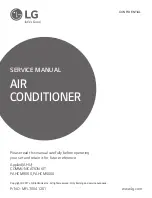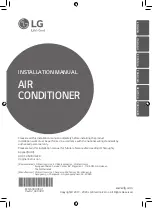
Routine Maintenance
CLCH-SVX013B-EN
73
9. Replace all panels and parts and restore electrical
power to the unit.
10. Be careful any contaminated material does not contact
other areas of the unit or building. Properly dispose of
all contaminated materials and cleaning solution.
Cleaning Porous Surfaces
WARNING
Hazardous Voltage!
Disconnect all electric power, including remote
disconnects before servicing. Follow proper lockout/
tagout procedures to ensure the power can not be
inadvertently energized. Failure to disconnect power
before servicing could result in death or serious injury.
To clean a porous insulating surface (fiberglass
insulation):
1. Disconnect all electrical power to the unit.
2. Wearing the appropriate personal protective
equipment, use a vacuum device with a HEPA filter
(99.97 percent efficient at 0.3 micron particles) to
remove the accumulated dirt and organic matter.
Note:
Be careful not to tear the insulation surface or
edges.
3. Confirm the drain line is open following the cleaning
process.
4. Allow the unit to dry thoroughly before putting it back
into service.
5. Replace all panels and parts and restore electrical
power to the unit.
6. Be careful any contaminated material does not contact
other areas of the unit or building. Properly dispose of
all contaminated materials and cleaning solution.
Coils
All coils should be kept clean to maintain maximum
performance.
Steam and Water Coils
WARNING
Hazardous Voltage!
Disconnect all electric power, including remote
disconnects before servicing. Follow proper lockout/
tagout procedures to ensure the power can not be
inadvertently energized. Failure to disconnect power
before servicing could result in death or serious injury.
WARNING
Hazardous Chemicals!
Coil cleaning agents can be either acidic or highly
alkaline and can burn severely if contact with skin
occurs. Handle chemical carefully and avoid contact
with skin. ALWAYS wear Personal Protective Equipment
(PPE) including goggles or face shield, chemical
resistant gloves, boots, apron or suit as required. For
personal safety refer to the cleaning agent
manufacturer’s Materials Safety Data Sheet and follow
all recommended safe handling practices. Failure to
follow all safety instructions could result in death or
serious injury.
To clean steam and water coils:
1. Disconnect all electrical power to the unit.
2. Wearing the appropriate personal protective
equipment, use a soft brush to remove loose debris
from both sides of the coil.
3. Install a block-off to prevent spray from going through
the coil and into a dry section of the unit and/or system
ductwork.
4. Mix a high-quality coil cleaning detergent with water
according to the manufacturer’s instructions.
Note:
If the detergent is strongly alkaline after mixing (PH
8.5 or higher), it must contain an inhibitor. Follow
the cleaning solution manufacturer’s instructions
regarding the use of the product.
5. Place the mixed solution in a garden pump-up sprayer
or high-pressure sprayer. If a high pressure sprayer is
to be used:
–
Maintain minimum nozzle spray angle of
15 degrees.
–
Spray perpendicular to the coil face.
–
Keep the nozzle at least 6 inches from the coil.
–
Do
not
exceed 600 psi.
6. Spray the leaving air side of the coil first, then the
entering air side.
7. Thoroughly rinse both sides of the coil and the drain
pan with cool, clean water.
8. Repeat steps 6 and 7 as necessary.
9. Straighten any coil fins that may have been damaged
during the cleaning process.
10. Confirm the drain line is open following the cleaning
process.
11. Allow the unit to dry thoroughly before putting it back
into service.
12. Replace all panels and parts and restore electrical
power to the unit.
13. Be careful any contaminated material does not contact
other areas of the unit or building. Properly dispose of
all contaminated materials.
Summary of Contents for Performance Climate Changer PSCA
Page 81: ......

































